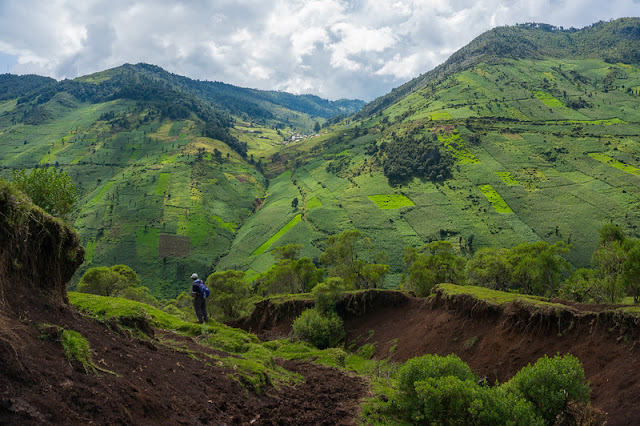PHOTOGRAPHS AND DRAWINGS
We were in the highlands of Guatemala where seismic and volcanic activity is ongoing. There are 4 different mountain ranges running more or less parallel from west to east, each of which curls slightly southward in the middle of the country. If that weren't enough to scramble the topography, each year up to 180 inches of rain has its way with the land. A renown French geographer, Jacques Elisee Recluse (1830-1905) was awarded a gold medal by the Paris Geographical Society for his 19 volume master work in which he described this area as "a stormy sea breaking into parallel billows."
As much as I wanted to draw what I was seeing it was obvious that it would be pointless. Photographs would make sense as they would be credible but any drawing of these bizarre formations and the helter skelter lay of the land would come across as just plain wrong. You wouldn't need to be a geologist, your natural instincts would tell you straight out that it was a sham. At best, it might be accepted as fantasy but any insinuation that it was accurate would seem ludicrous. As an example, how ridiculous would it be to draw and old volcano that sported a lake on top?
I was able to find things to draw when we stopped in Antigua. This town is pretty much required for every tourist visiting Guatemala and each of them has at one time taken a picture of the Santa Catalina Arch shown below. It was put there in the 17th century to allow the cloistered nuns to avoid the street as they passed between the Santa Catalina Convent and a school across the street. I was also told that this same discrete route was available to the priests at the school who wished to visit the convent. There are so many images of this on the internet I drew it twice out of spite.
I haven't learned how to draw people yet but these 2 women had their backs turned.
The place we stayed at in Antigua had a central courtyard that was ringed with a trellis full of clock vine flowers.
Everybody's wearing art
On to Quetzaltenango and a church that fronts the central plaza.
In the village of San Martin at 8,000 feet, I climbed 4 stories to the roof of the new Xela AID building and found a patchwork of small farms to draw.
Last stop, Lake Atitlan, claimed by Aldous Huxley and many others as the "most beautiful lake in the world." We stayed at the Casa Del Mundo, a place that compliments the lake perfectly and where I did the last of my drawings. The hotel is built into a cliff overlooking the lake and 3 volcanoes on the horizon. The view from my room was the shoreline to the right of this picture.
Everywhere you go, plants and stairways cascade down the cliff to the lake below.
I'll be back.























